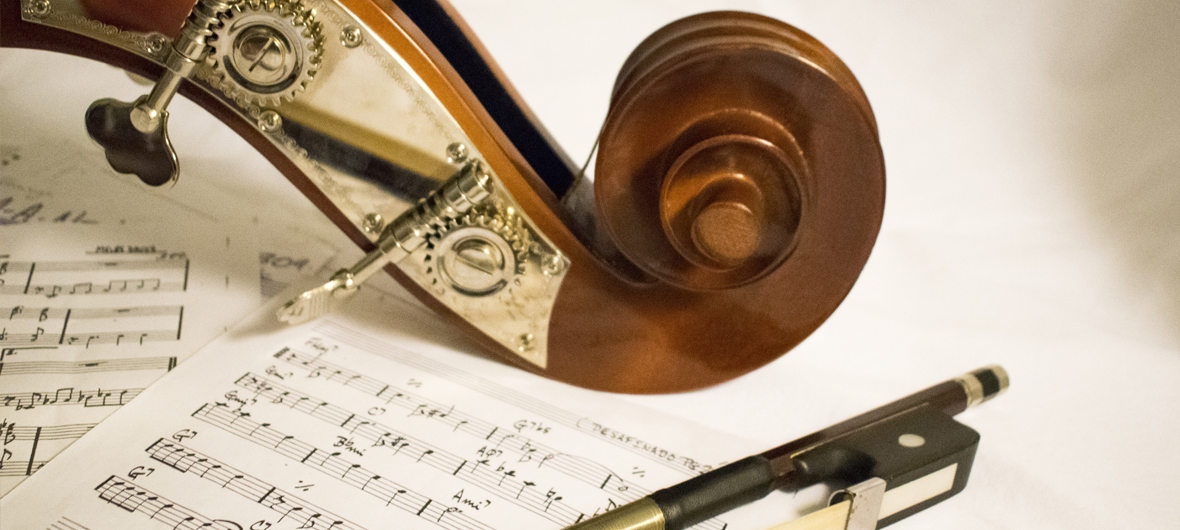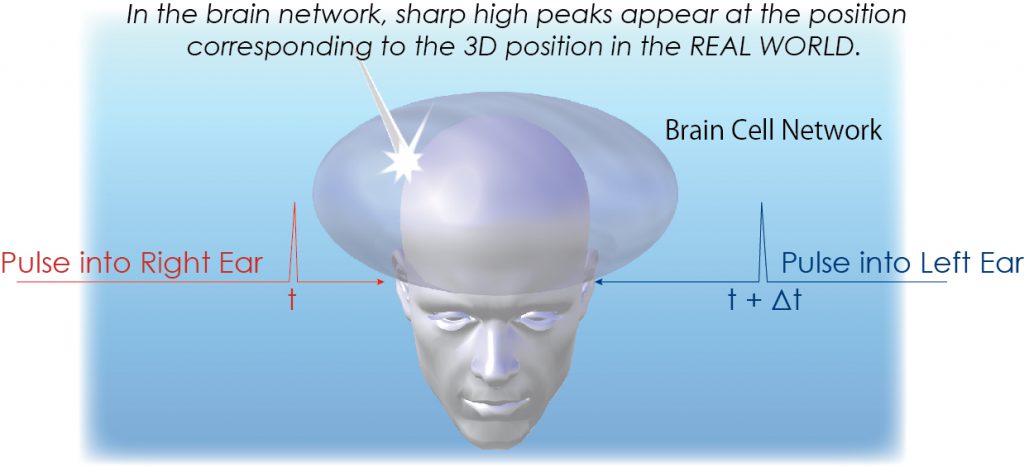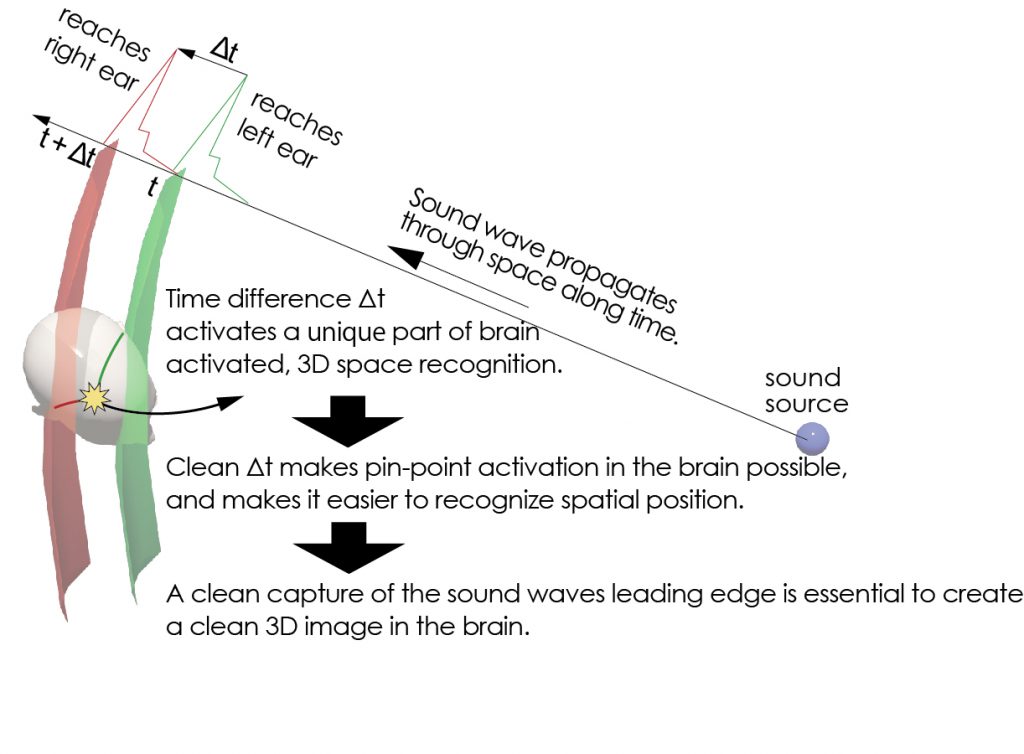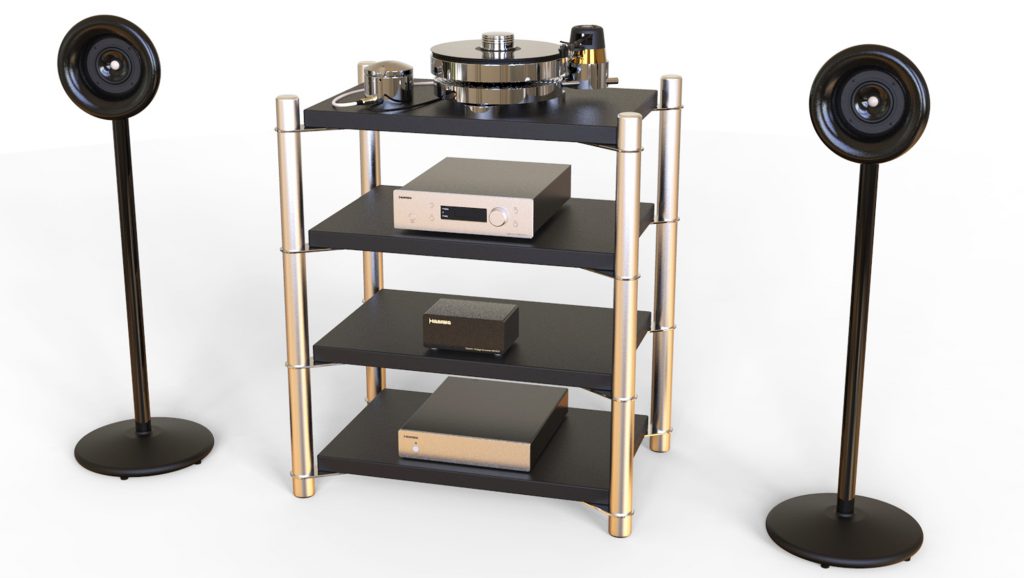Haniwa REAL 3D AUDIO
How do we sense sound?
Arguably, the human organ that “hears” sound is the brain. The eardrum is the sensor, but the brain processes the precise timing and frequencies of natural sound and interprets complexities of the signal. The ability to sense precise sound direction was critical for our survival as humans and is still buried deep in our DNA. Indeed, our senses are even heightened in the evening because our distant ancestors needed to sense approaching danger and its direction over the crackling of a fire. The evening is still the best time of day to listen to music because of our heightened senses.
If we consider an upright acoustic bass being played in the rhythm section of a Jazz band, we certainly hear the deep bass note frequencies. But we also hear the sharp high frequency “pluck” and sliding of the musicians’ fingers on the fingerboard. We also “hear” the energy and passion of the artist. The precise timing of these sounds is critical for the instrument to sound like a real acoustic bass and to duplicate the performance exactly as it existed. When you add the drums, piano and saxophone our brain processes the beautiful complexities of music with multiple sound sources coming from multiple musicians simultaneously recreating the “space” of the performance.
How does Haniwa realize 3D Audio?
Make the output equal the input. This is the driving philosophy of Haniwa. The music output at the speaker should be the same as the input from the recorded media, whether from a CD player, turntable or streaming file. Make the output equal to the input is quite simple from a philosophy standpoint, but impossible to achieve in typical component analog system and very difficult to achieve even with digital systems. Haniwa has spent decades developing a music reproduction system that achieves this goal with precise timing, phase and frequency control that we call Haniwa 3D Audio. We call it “3D audio” because Haniwa recreates a precise 3D soundstage in your listening room so you can get as close as possible to the original performance.
When reproducing recorded music, precise control of the tiny sound gaps that occur from left ear which deliver a 3D sound stage is critical to replicate the artists performance. We do this by taking an integrated systems approach and leveraging advanced digital technology. All of Haniwa’s processing is done at 24bit/192Khz since the human brain can resolve time differences of 5μs which is equivalent to 200kHz. We control the frequency and phase curves to deliver optimal performance as demonstrated by ideal impulse and step response. More about that later … We use speakers that have a single driver and thus precise focus. Typical multi-way speakers do not have a single point of focus and degrade the timing and phase by using crossover networks that split the signal to the delivery of multiple drivers. The result of this process is a blurring of the sound and a corruption of the original music signal. The systems based technology behind Haniwa 3D Audio is completely different from any other audio systems on the market. You can hear the difference with only one note from a piano reproduced on Haniwa.
In addition to using single driver speakers to deliver a focused image, we have developed a proprietary Digital Signal Processor based technology that precisely controls and adjusts the audio signal in real time to achieve optimum characteristics of the system at the speaker output (impulse response and step response). Optimum Impulse response is a pulse with high peak over the shortest time interval. Haniwa has a “near perfect” impulse response which is close to 1. This means that the output pulse from the speaker is almost identical to the input response of the signal (see https://www.stereophile.com/features/100/index.html). Optimum step response looks literally like a step, with a sharp vertical rise in the signal and then a flat trailing signal (see https://www.stereophile.com/content/measuring-loudspeakers-part-two-page-2). Haniwa has an ideal step response as well. The capability of an audio system to reproduce audible sound with the proper phase and amplitude for all frequencies is captured in these curves. By controlling these curves, Haniwa delivers the sharpness of a sounds leading edge that generate distinct pulse recognition in your brain. It is worth noting that most all high end speakers have poor impulse and step response, even speakers that cost more than 10x the price of Haniwa.
How do we know if the recorded waveform is accurately reproduced by an audio system?
– When analyzing the waveform, the time-domain data (the music signal along time) is used. In the time domain, Impulse Response theory is used for checking the waveform preservation and accuracy.
– Impulse response testing uses a signal containing the frequency entire bandwidth from the lowest to the highest, with an almost zero duration, and a near infinite peak. This idealized signal is called an Impulse signal.
– If a system receives the signal and outputs the signal without change at the speakers, the system can accurately reproduce any waveform and the Impulse response is equal to 1.

Do we know the actual Waveform of the Output Sound from the speaker system?
Comparison of the audio sound waveform against the input waveform is rarely publicized. Below is an example; the blue curve is the input signal taken from Art Pepper’s famous saxophone performance, and the red curve is its sound played back by the Haniwa system. The output waveform is accurately tracking the original music signal, without missing the saxophone’s characteristic sharp shape, peak position and its height.

In contrast, below is an example actually measured in the same way with a popular and very expensive multi-driver speaker system. It is easily recognized that the polarity is not preserved, and peaks are much lower. With this deteriorated waveform, the reality of the input sound is not preserved, and the timing of rising edge signals are vague resulting in a blurred spatial presence. Due to these factors, this playback speaker system is not accurately reproducing the original music, which is the sole purpose of an audio system!

How is the performance of the audio system optimized?
True optimization of the systems impulse response is possible only by controlling the system as a whole.
The Process of Optimization Used to Design Haniwa
1. We selected a single cone full range driver so that the speaker itself has smooth natural characteristics without dips and spikes, which makes it easier to adjust the waveform in the DSP.
2. An impulse signal is sent into the system, the output is observed, and the DSP parameters are adjusted so that the output sound becomes a higher and more narrow response.
3. The process above is repeated to make the output pulsive sound as High and narrow as possible to realize Haniwa REAL 3D AUDIO
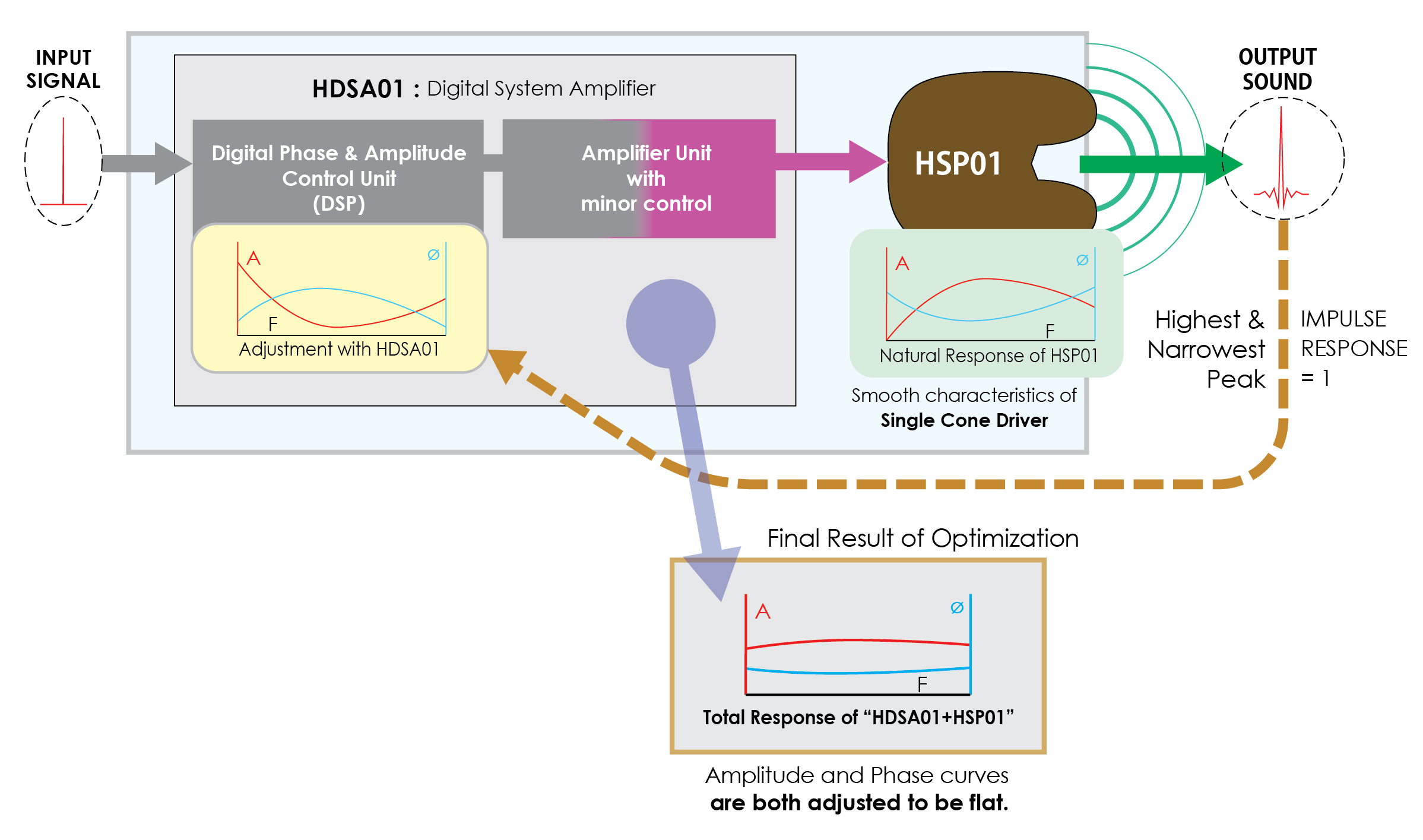
How does the actual measurement data of Haniwa compare with traditional systems?
TOOLS USED FOR THE EVALUATION OF SOUND
IMPULSE RESPONSE = 1: Means the waveform is preserved. Pulse sharpness is the sharpness of a transient sound.
STEP RESPONSE : Is derived (post-processed) from the impulse response. Its rising edge shows transient sharpness. The Step response trailing shows the transient impact power of the system. If it is not smoothly sustained, the sound loses its concentrated impact.

In addition to using single driver speakers to deliver a focused image, we have developed proprietary Digital Signal Processor based technology that precisely controls and adjusts the audio signal in real time to achieve optimum characteristics of the system at the speaker output (Impulse Response and Step Response). Optimum Impulse Response is a pulse with high peak over the shortest time interval. Haniwa has a “near perfect” impulse response which is close to 1. This means that the output pulse from the speaker is almost identical to the input pulse of the signal. Optimum step response should look like a step, with a sharp vertical rise in the signal and then a flat trailing signal. Haniwa has an ideal step response as well. The capability of an audio system to reproduce audible sound with the proper phase and amplitude for all frequencies is captured in these curves. By controlling these curves, Haniwa delivers the sharpness of a sounds leading edge that generate distinct pulse recognition in the brain. It is worth noting that most high-end speakers have poor impulse and step response, even speakers that cost more than 10x the price of Haniwa (see figure 1)
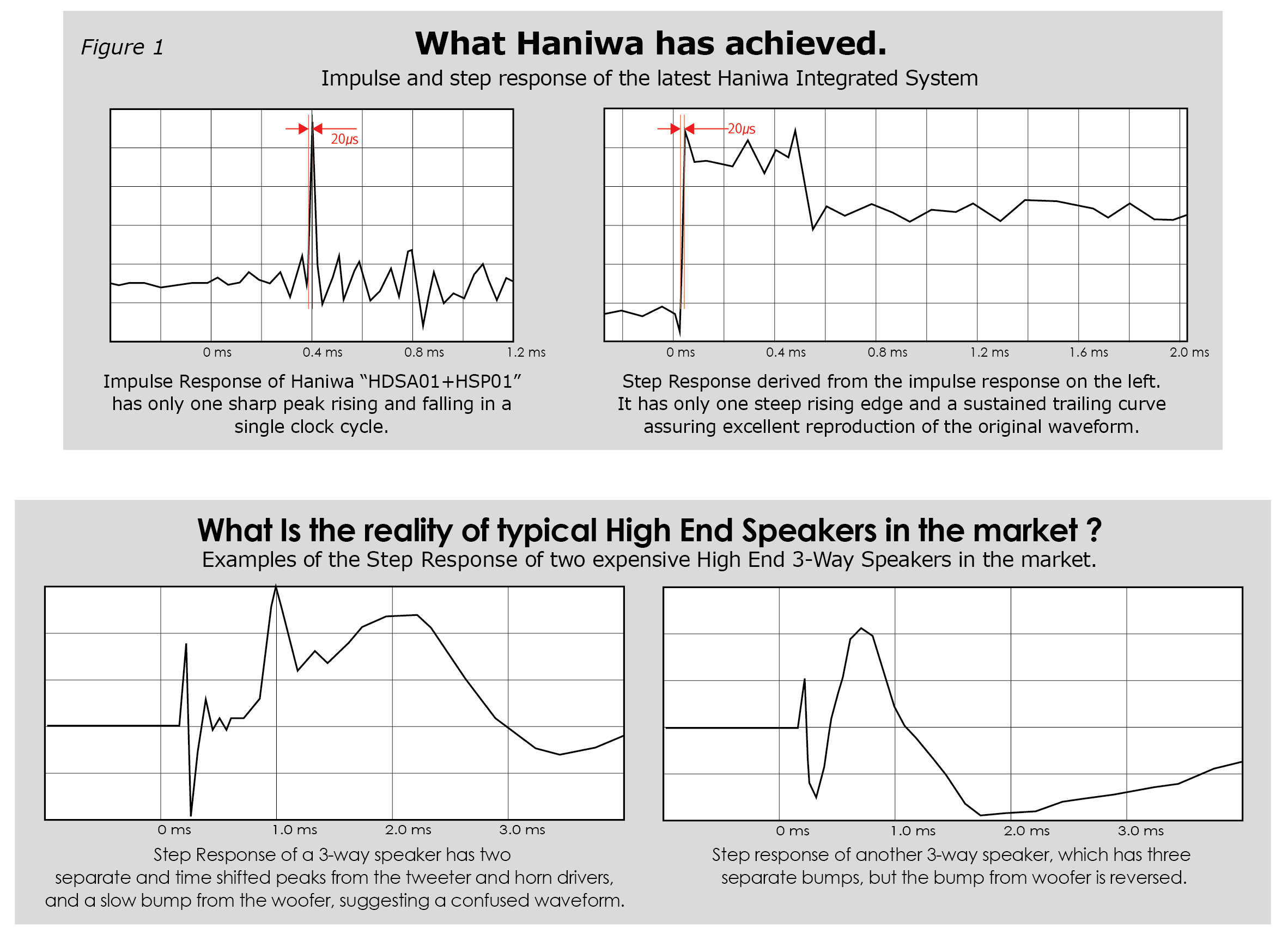
Fully Integrated REAL 3D Audio System
The Haniwa system is designed to reproduce music with the highest fidelity of the original performance. It consists of a pair of small resonance-free, full range speakers and an Integrated System Amplifier uniquely tuned to drive those speakers.
The HDSA01 Integrated Amplifier processes input signals at 192kHz/24bit format, and drives the HSP01 full-range speakers, after applying precise adjustments of a flat frequency response combined with almost zero phase-shift.
Precise and faithful reproduction of music is the sole purpose of an audio system. It is achieved uniquely by Haniwa where the input waveform exactly matches the physical output sound. At Haniwa we believe that the definition of the perfect audio system is one that exactly and faithfully reproduces your music.

